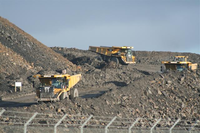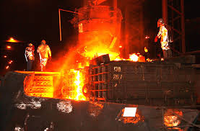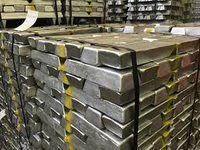Difference between revisions of "Extraction of Metals"
| Line 34: | Line 34: | ||
: Transporting [[ore]] produces [[Carbon Dioxide]] which contribute to [[Global Warming]]. | : Transporting [[ore]] produces [[Carbon Dioxide]] which contribute to [[Global Warming]]. | ||
: [[Metal Refinery|Metal refineries]] produce [[Carbon Dioxide]] as well as other [[pollution]] including [[Sulphur Dioxide]] and [[Nitrous Oxide]]s which lead to [[Acid Rain]]. | : [[Metal Refinery|Metal refineries]] produce [[Carbon Dioxide]] as well as other [[pollution]] including [[Sulphur Dioxide]] and [[Nitrous Oxide]]s which lead to [[Acid Rain]]. | ||
| + | |||
| + | ==Key Stage 4== | ||
| + | ===Meaning=== | ||
| + | '''Extraction of Metals''' is the process of removing a [[metal]] from a [[Metal Compound|metal compound]]. | ||
| + | |||
| + | ===About the Extraction of Metals=== | ||
| + | There are 2 methods for '''extracting metals''' from [[Metal Compound|metal compounds]]: | ||
| + | *[[Extracting Metals by Electrolysis|Electrolysis]] - Which can be done for all [[metal]]s, but usually only those more [[reactive]] than [[Carbon]] on the [[Reactivity Series|reactivity series]]. | ||
| + | *[[Smelting]] - Which can be done for [[metal]]s less [[reactive]] than [[Carbon]] on the [[Reactivity Series|reactivity series]]. | ||
| + | |||
| + | : The method chosen to '''extract a metal''' depends on the [[energy]] needed. | ||
| + | : [[Smelting]] requires very high [[temperature]]s to [[melt]] the [[mineral]]s from the [[ore]]. | ||
| + | : [[Extracting Metals by Electrolysis|Electrolysis]] can be done in [[solution]] with water at low [[temperature]]s if the [[mineral]] is [[soluble]] and the [[metal]] does not [[Chemical Reaction|react]] strongly with [[water]]. However for [[insoluble]] [[mineral]]s and [[metal]]s which do [[Chemical Reaction|react]] with [[water]] then high [[temperature]]s are needed to [[melt]] the [[mineral]]. | ||
Revision as of 11:09, 25 January 2019
Contents
Key Stage 3
Meaning
Extraction of Metals is how we get usable metal from ore found in the ground.
About Extraction of Metals
There are 3 main ways extraction of metals takes place:
- None - Elements below Hydrogen are found Native which means the metal element can be found not as part of a compound.
- Smelting - Elements above Hydrogen but below Carbon are found in minerals, which are metal compounds so they need to be extracted by using Carbon to displace the metal from the compound.
- Electrolysis - Elements above Carbon are found in minerals but they cannot be extracted with Carbon because Carbon is less reactive than those metals so we use electrolysis to extract them.
| The ores are mined from the ground using explosives and heavy machinery. | The ores are transported to metal refineries by trucks, trains and boats. The metal refineries can be thousands of miles away. | The material is purified to remove unwanted pieces of rock. If the metal is native it is put in a furnace to melt. If the metal is in a compound it is either put in a furnace with Carbon to displace it or it is placed in an electrolysis cell to be extracted with electricity. | The metal is then molded into ingots before being transported again to where they are needed. |
Environmental Concerns
- All stages of the extraction process can cause damage to the environment and concerns are raised about the local impact and global impact of extraction.
Local Concerns
- A large area of land is destroyed to make space for a quarry. This can be habitats for local organisms.
- Local people complain of increased traffic.
- Explosives are often used in mining which can disturb local people and wildlife.
- People who live near metal refineries can be affected by the pollution given off by the refinery.
Global Concerns
- Machines used to mine produce Carbon Dioxide which contribute to Global Warming.
- Transporting ore produces Carbon Dioxide which contribute to Global Warming.
- Metal refineries produce Carbon Dioxide as well as other pollution including Sulphur Dioxide and Nitrous Oxides which lead to Acid Rain.
Key Stage 4
Meaning
Extraction of Metals is the process of removing a metal from a metal compound.
About the Extraction of Metals
There are 2 methods for extracting metals from metal compounds:
- Electrolysis - Which can be done for all metals, but usually only those more reactive than Carbon on the reactivity series.
- Smelting - Which can be done for metals less reactive than Carbon on the reactivity series.
- The method chosen to extract a metal depends on the energy needed.
- Smelting requires very high temperatures to melt the minerals from the ore.
- Electrolysis can be done in solution with water at low temperatures if the mineral is soluble and the metal does not react strongly with water. However for insoluble minerals and metals which do react with water then high temperatures are needed to melt the mineral.



